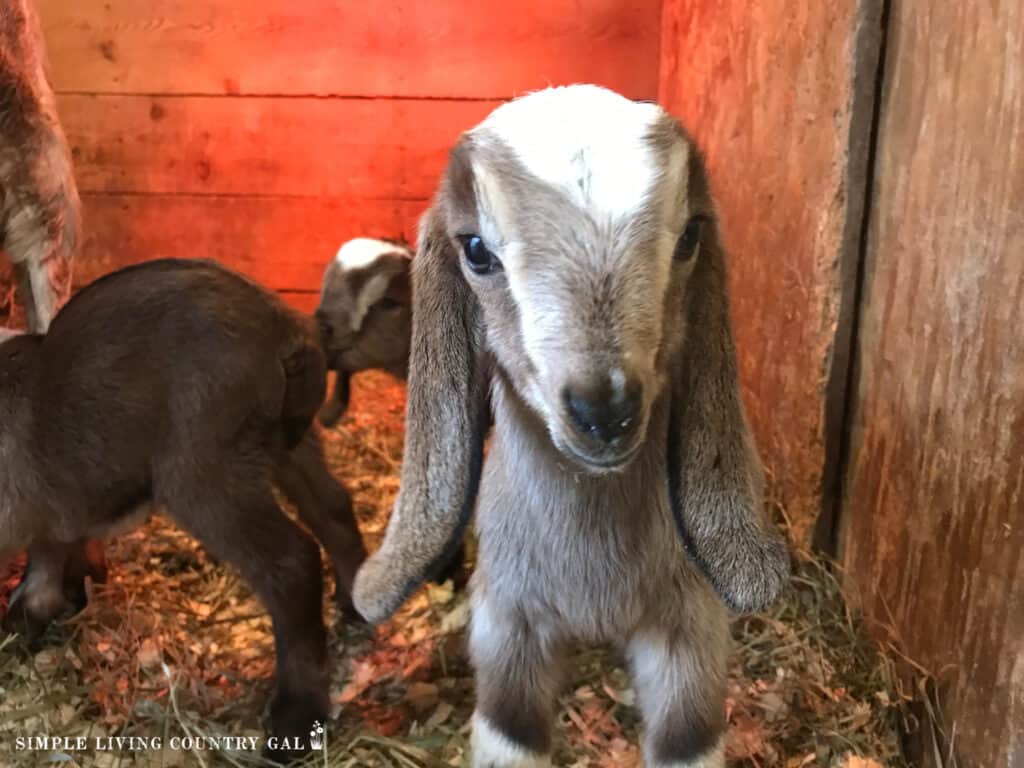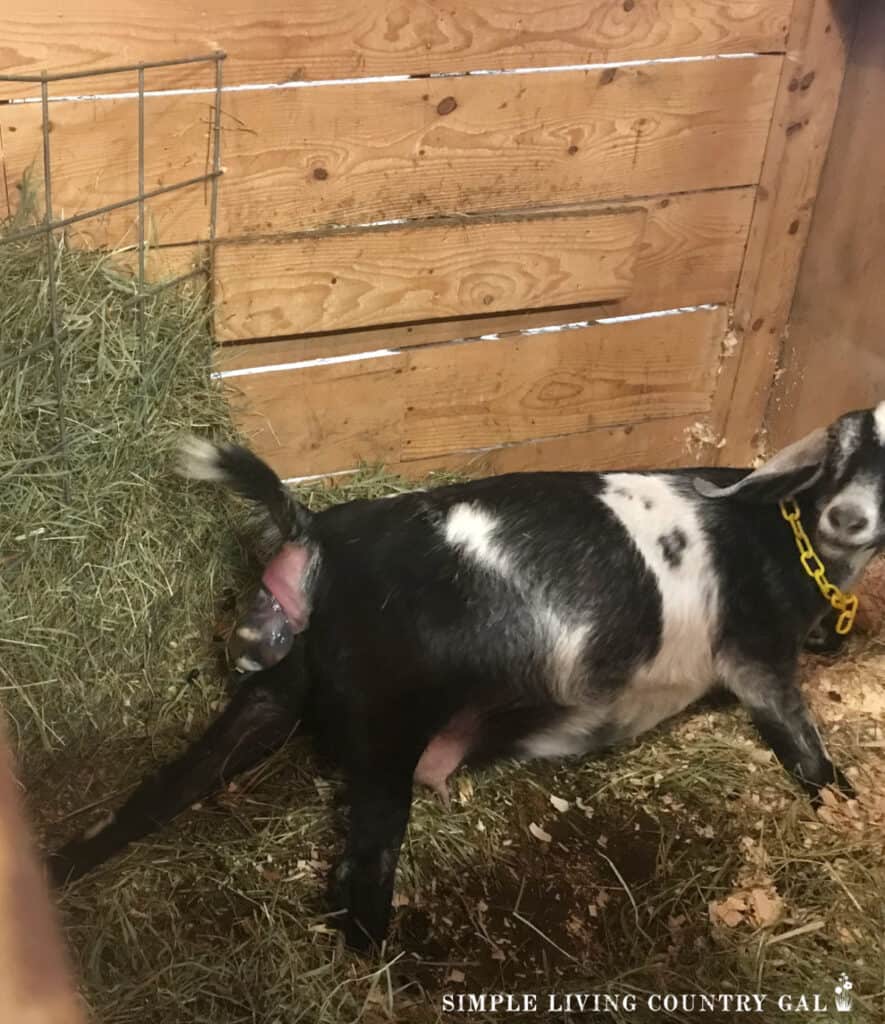How do you Know When a Goat is Done Giving Birth?
Goat kidding is always an exciting time on a homestead, but it can be scary as well. You want to help, but you may not be sure if there is a reason to. If this sounds like you, then this article on how do you know when a goat is done giving birth will help.
Knowing when labor is over is an important part of goat breeding and goat kidding, and my goal is to give you a better idea of when things are done.

Baby goats might be my favorite part of spring; babies of all kinds really help to make the hard work all the rest of the year worth it. But many times, we, as livestock owners, tend to get nervous, stressed out, and overwhelmed by the birthing process.
The good news is that 95% of all goat kiddings go off without an issue. I can even tell you of a few times when I went out to our barn and found a new mom resting with cleaned-off, dry, and alert baby goat kids.

And yes, it’s true that your goats can do things on their own; it is also true that there will be times when you will need to step in and help.
Disclaimer: In accordance with FDA guidelines, the information and products offered on this website are not intended to diagnose, treat, cure, or prevent any disease. I am not a medical professional. Before administering any medications to your animals please contact a veterinarian first.
How long does it take for a goat to finish giving birth?
The answer to this question can vary quite a bit, mainly based on the age of the goat, its breed, and overall health. In general, a goat’s labor can take anywhere from 30 minutes all the way to 12 hours and sometimes longer. Once you see the water sack emerge, kids usually hit the ground in about an hour’s time.
Knowing the length of kidding is a good place to start but even more important is knowing when she is finished. Let’s talk about that now.

How do you Know When a Goat is Done Giving Birth?
There are a few clear-as-day things to watch for when a goat is finished kidding, but just in case you miss the obvious, there are a few subtle things that can help you know as well.
#1. The afterbirth is out.
After the goat has successfully delivered the kids, you should see the afterbirth on the ground. This is the most obvious sign that kidding has been completed. Normally, you should see the afterbirth out within an hour or two after the last kid is born. The goat mother may eat part or all of the placenta, which is a little off-putting but normal behavior. We had a goat that would never completely expell her placent, if yours does the same, you should consult a veterinarian as this could indicate a post-kidding complication known as retained placenta.
What to Know: Do not EVER pull a placenta, as this can greatly harm your goat.
#2. The discharge changes color.
During the birthing process, you may notice a discharge that is clear or pink in color. After giving birth, this discharge should be a darker red-brown color and may contain some small clots. This is normal and indicates that the uterus is contracting back to its pre-pregnancy size.
What to Know: If the discharge remains clear or pink, it may be a sign of retained placenta and should be checked by a veterinarian.
#3. The goat is no longer straining.
During labor, a goat will have contractions that cause them to strain and push during the birthing process. Once all kids are born, and the afterbirth is expelled, this straining should stop. If the goat continues to strain for an extended period of time, it could be a sign that there are more kids or retained placenta still inside, and a veterinarian should be consulted.
#4. The doe is calm and settled.
After kidding is done, a doe will typically become calmer and more settled. She will clean her kids, lay down with them, and chew her cud. These are all great signs that kidding is over.
If the doe continues to be restless or agitated, it could be a sign of post-kidding complications such as retained placenta or uterine infection. It is important to watch your doe closely during this time and seek veterinary assistance if necessary.
Remember to keep accurate notes on kiddings for each of your goats. This information is crucial to creating a breeding and kidding routine with your healthiest and robust does.
Goat Kidding Supplies:
Agri-Pro Enterprises Lamb and Goat Kid Feeding Kit 1- Tube (14Fr), 1-Syringe (60 ML)



#5. Her stomach feels soft.
After giving birth, a goat’s stomach should feel soft and less distended. This is because the kids have been born and the afterbirth has been expelled. If the goat’s stomach remains hard or visibly swollen, it could be a sign of retained placenta or other post-kidding complications that require medical attention. It is important to monitor the goat’s stomach and overall health after giving birth to ensure she is recovering properly.
Disclaimer: In accordance with FDA guidelines, the information and products offered on this website are not intended to diagnose, treat, cure, or prevent any disease. I am not a medical professional. Before administering any medications to your animals please contact a veterinarian first.
What can you do if a goat’s labor has stalled?
If a goat’s labor has stalled, your first course of action should be to contact a veterinarian immediately. While waiting for the vet, make sure the doe is in a calm and stress-free environment. You can also ensure she is adequately hydrated, as dehydration can sometimes lead to labor problems.
Do not attempt to assist the labor yourself unless you have been trained to do so, as this could cause injury to both the doe and the kids. Remember, professional veterinary care is essential in such situations to ensure the health and safety of your animals.
Things to Know: It’s true not all vets treat livestock; if this is the case in your area, reach out to your vet and see if you can ask for tips on treatment and care of your goats. More often than not, they will be more than happy to assist you over the phone and walk you through any issues and care you need help with.

Raising goats can be a rewarding experience, with unique challenges and fun surprises. Remember to be close if needed, but do not hover while your goat is kidding. This will keep everyone involved and relaxed throughout the process.
Knowing when your goat is done giving birth is a great skill to have before any kidding season. Get more tips on goat kidding by checking out some of our other articles below. Good luck and happy kidding!





